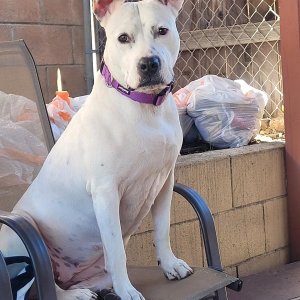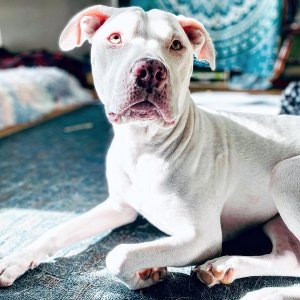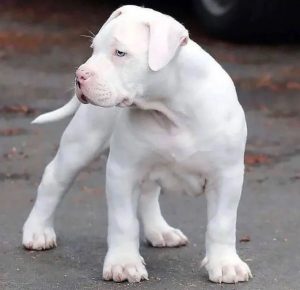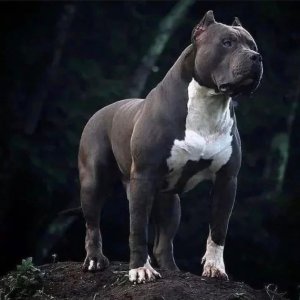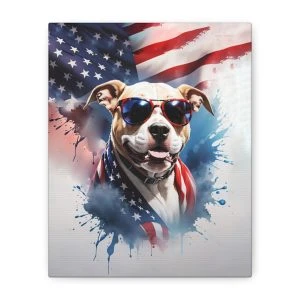White Pitbulls
White Pitbulls: How Do They Get Their Appearance?
A white pit bull is a type of American Pit Bull Terrier with a dominant gene resulting in a white coat color. The American Pit Bull Terrier breed is known for its strength, loyalty, and affectionate nature, and the white coat color is simply a variation of their physical appearance.
The white coat color in pit bulls is caused by the presence of a dominant gene that suppresses the expression of other coat color genes. This results in a uniform white coat with no other markings or patterns. However, white pit bulls may still have dark eyes, noses, and pigment on their ears and paw pads.
Pure White Pitbulls have a short, smooth coat that is dense and shiny. They are a solid white color with no markings or patches of any other color. Their coats are usually easy to groom and maintain, requiring minimal brushing to keep them looking neat and healthy. Some white American Pitbulls may have a slight cream or ivory tint to their coat, but for the most part, they are pure white color.
However, white coat color in Pitbulls does not indicate a different breed or any difference in temperament or behavior compared to pit bulls of other coat colors.
Additionally, coat color in pit bulls does not affect their suitability as pets or their ability to participate in various activities, such as obedience, agility, and weight pulling.
Full-grown White Pitbulls typically reach a height of 18 to 21 inches (45 to 53 cm) at the shoulder and weigh between 30 to 60 pounds (13 to 27 kg). However, their size can vary slightly based on their specific bloodline and genetics.
White Pitbulls are generally muscular dogs. They have a compact, athletic build, well-defined muscles, and a strong, sturdy appearance. Their muscularity is a result of their breeding history as working dogs, and it is a vital characteristic of the breed. Despite their muscular build, they are also known for their agility and endurance, making them a versatile breed for various activities such as obedience training, weight pulling, and agility competitions.
White Pitbull Color Genetics
White color in Pitbulls is caused by a recessive gene called “albino.” Albino dogs cannot produce melanin, the pigment that gives color to the skin, fur, and eyes.
However, true albinos are very rare in dogs, and most American white Pitbull dogs have a genetic variation known as ‘piebald.’ Piebald dogs have a dominant white spotting gene that causes large areas of white fur.
Inheritance of the white color in Pitbulls is complex and can involve multiple genes, including the piebald gene, the extension gene, and the agouti gene. The exact combination of these genes determines the pattern and amount of white fur on the dog.
It’s also worth mentioning that some dog breeds, such as American Staffordshire Terriers, American Bully, and Staffordshire Bull Terriers, have a breed standard that disqualifies them from showing or breeding if they are predominantly white. This is due to historical associations with dog fighting, where white dogs were often used as “bait” to train other fighting dogs.
Albinism vs. Leucism
Albinism and leucism are both genetic conditions that affect the coloration of an animal’s fur, skin, and eyes. However, they differ in the way they cause a lack of pigmentation.
Albinism is a genetic condition that results in a complete absence of melanin production. This leads to a lack of color in the fur, skin, and eyes and vision problems due to the underdeveloped iris and retina. Albinos have pink or red eyes due to the blood vessels showing through the iris.
Leucism, on the other hand, is a genetic condition that results in a partial loss of melanin production. This leads to an animal having white or patchy white fur, but the skin and eyes retain some color. Unlike Albinos, animals with leucism have normal-colored eyes.
History
White Pitbulls are a variation of the American Pitbull Terrier, a breed that originated in England in the 19th century. The breed was originally developed for bull-baiting, but when that sport was banned, the dog breed was used for dog fighting. In the early 20th century, the breed’s image began to change as they were used as family pets, search and rescue dogs, and police dogs. Today, the American Pitbull Terrier white is a beloved pet known for its loyalty, affection, and bravery. The white color is a result of a genetic mutation that affects the pigmentation of the coat. While white Pitbulls are not a separate breed, they are becoming more popular as a unique color variation.
Temperament and Personality
The personality and temperament of a white Pitbull dog can vary, as it is largely determined by their individual upbringing, training, and socialization. However, American Pitbull Terriers are generally known for being friendly, affectionate, and good-natured dogs. They are loyal to their families and can be great with children. They are also known for their strong work ethic and high energy levels, making them good candidates for sports like agility and weight pulling.
That being said, any breed of dog can develop behavioral problems if they are not properly trained and socialized. In addition, Pitbulls have a strong prey drive, which can sometimes lead to aggressive behavior towards other small animals. Early and consistent training, as well as proper socialization, can help prevent these issues.
Training and Exercise Requirements
White Pitbulls, like all American Pitbull Terriers, are high-energy dogs requiring plenty of exercises and mental stimulation to stay happy and healthy. They are generally active and enjoy participating in physical activities, such as agility, weight pulling, and running. A daily walk and playtime will help keep your Pitbull physically and mentally stimulated.
In terms of dog training, Pitbulls are highly intelligent and respond well to positive reinforcement training methods. Consistency and patience are key when training a Pitbull, as they can sometimes be stubborn. It’s better to start training and socialization at a young age, as this will help prevent behavioral problems later in life. Basic obedience training and behavior modification should be a priority for all Pitbull owners.
It’s crucial to provide mental stimulation for your Pitbull by engaging them in interactive games and training exercises. Regular exposure to new people, animals, and environments can help your Pitbull become a well-rounded and confident dog. With proper dog training, exercise, and socialization, a white Pitbull dog can make a loving and loyal companion.
Are White Pitbulls Rare?
White Pitbulls are not considered rare but relatively uncommon compared to other Pitbull colors, such as brindle and fawn. The white coloration in Pitbulls can result from a recessive gene, but it is not considered a unique or rare trait.
Do White Pitbulls Go Deaf?
White Pitbulls, like other dogs with white coats, may be more prone to deafness compared to dogs with darker coats. This is due to a genetic condition called piebaldism, which can affect the development of melanocytes, the cells responsible for producing pigment in the body, including the inner ear.
However, not all white Pitbulls are deaf, and deafness can also occur in dogs of any color for other reasons, such as age-related hearing loss or exposure to loud noises.
It’s always a good idea to check your dog’s hearing regularly with a veterinarian to ensure their overall health and well-being.
Do White Pitbulls Need Sunscreen?
Like other dogs with light-colored or thin fur, White Pitbulls may benefit from sunscreen when spending time outdoors in sunny conditions. Their lighter skin is more susceptible to sunburn and skin damage.
Sunscreen for dogs can be applied to their ears, nose, and any other exposed skin to protect them from harmful UV rays. However, pet owners should use sunscreen specifically formulated for dogs, as some human sunscreens contain ingredients that can be toxic to dogs if ingested.
It’s always a good idea to consult your veterinarian to determine the best sunscreen options for your white Pitbull terrier and ensure its overall health and well-being.
How Long Do White Pitbulls Live?
The lifespan of a white Pitbull is, on average, 12 to 16 years. This is similar to the lifespan of other Pitbulls and many other breeds of similar size. Genetics, diet, exercise, and veterinary care can all play a role in a Pitbull’s lifespan. Providing your Pitbull white dog with proper care and nutrition can help ensure they live a long and healthy life.
Common Health Conditions
Like all breeds, white Pitbulls can be prone to certain health conditions. However, not all Pitbulls will develop these issues and that many can live long, healthy lives. The following is a list of common health conditions that can affect white Pitbulls:
Hip dysplasia:
A genetic condition in which the hip joint does not develop properly, leading to arthritis and pain.
Allergies:
Pitbulls can suffer from skin or food allergies, which can cause itching, hair loss, and skin irritation.
Ear infections:
Due to their floppy ears, Pitbulls are prone to ear infections, which can cause pain, swelling, and discharge.
Bloat:
A potentially life-threatening condition in which the stomach twists on itself, cutting off blood flow.
Heart conditions:
Some Pitbulls may be prone to heart conditions, such as dilated cardiomyopathy or aortic stenosis.
Eye problems:
Some Pitbulls may suffer from eye problems, such as cataracts or cherry eyes.
Skin problems:
Pitbulls may suffer from skin problems, such as skin allergies, hot spots, or mange.
Demodectic mange:
A skin condition caused by mites that can lead to hair loss and skin irritation.
It’s crucial to have your Pitbull regularly examined by a veterinarian to catch and treat any health issues as soon as possible. Additionally, feeding a well-balanced diet and providing regular exercise can help maintain your Pitbull’s health and prevent some of these conditions from developing.
Food and Diet Requirements
White Pitbulls require a balanced and nutritious diet to maintain their health and energy levels. As with any breed, the exact dietary needs will vary depending on age, weight, and activity level.
A high-quality dog food that meets the nutritional needs of a large breed should be fed to a white Pitbull. This should include protein from animal sources, carbohydrates for energy, healthy fats, and essential vitamins and minerals. Some Pitbulls may also benefit from supplements, such as joint support supplements, if they are prone to common problems.
You should feed your Pitbull the appropriate amount of food to maintain a healthy weight, as obesity can lead to several health problems. Always monitor your Pitbull’s food intake to prevent overeating, as this can lead to weight gain and other health issues.
As with any breed, it’s better to consult your veterinarian to determine the best diet for your Pitbull white dog based on its individual needs. They can help you determine the appropriate portion size and frequency of feeding for your Pitbull.
Grooming and Shedding
White Pitbulls have a short, smooth coat that requires minimal grooming. They are moderate shedders so you may notice some hair around your home, but regular brushing can help control shedding and keep your Pitbulls coat shiny and healthy. Brushing your Pitbull once or twice a week will help remove loose hair and distribute skin oils throughout its coat.
In addition to brushing, you should regularly check your Pitbull’s ears and clean them as needed to prevent ear infections. Their nails should also be trimmed regularly to prevent cracking and splitting. Bathing your Pitbull as needed with a gentle shampoo can help keep its skin and coat clean and healthy.
Overall, the grooming needs of a white Pitbull are minimal, making them a low-maintenance breed for those who want a dog that’s easy to care for.
White Pitbull Adoption
Adopting a white Pitbull can be a wonderful way to bring a new furry friend into your life. Here are some steps to help you with the process:
- Research: Familiarize yourself with the breed and its characteristics to determine if a white Pitbull fits your lifestyle.
- Find a reputable rescue or shelter: Look for a local rescue organization or animal shelter that specializes in Pitbulls, or consider contacting breed-specific rescues.
- Meet the dogs: Arrange a visit to meet the dogs available for adoption to see if you have a connection with one of them.
- Check the dog’s history: Ask the rescue or shelter about the dog’s background, including its age, health, and behavior.
- Take your time: Adopting a dog is a big decision, so take your time and make sure you’re ready for the commitment.
- Prepare for the arrival: Make sure you have everything your new Pitbull will need, including food, a bed, toys, and a crate.
- Ongoing care: Remember that adopting a Pitbull is a lifetime commitment, so be prepared to provide the necessary care, including training, exercise, and veterinary care.
Following these steps and researching the breed can help ensure a successful adoption and a happy, healthy life for your white Pitbull.
Level of Experience Required to Own a White Pitbull
Owning a white Pitbull requires a commitment to providing a safe and loving home and meeting its physical, emotional, and behavioral needs. The experience level required to own a Pitbull white will depend on several factors, including:
Training:
Pitbulls are highly trainable, but they do require consistent and firm training to help them develop good manners and obedience skills. New owners should have experience training dogs or be willing to take training classes with their new companions.
Exercise:
Pitbulls are active and energetic dogs that require daily physical exercise, including walks and playtime. New owners should be physically fit and able to provide their Pitbull with the exercise they need.
Time and attention:
Pitbulls thrive on human interaction and companionship, so owners should be prepared to spend significant time with their dogs, including playing, training, and providing affection.
Space:
Pitbulls do best in homes with a securely fenced yard where they can run and play. If you live in an apartment or have a small yard, you should be prepared to provide additional exercise and training to keep your Pitbull happy and healthy.
Understanding breed misconceptions:
Pitbulls have a bad reputation in some quarters. So Pitbull owners should be knowledgeable and confident in protecting their breed.
Owning a Pitbull white dog requires a strong commitment to providing the necessary care, attention, and training. If you are prepared for the challenges and rewards of owning a Pitbull, you can be a loving and loyal companion for many years.
White Pitbull Puppies
White Pitbull puppies are adorable and playful, but they also require a significant investment of time, money, and effort to raise and care for properly. Here are some things to consider when caring for white Pitbull puppies:
- Feeding: Provide a balanced and nutritious diet that meets the nutritional needs of a growing puppy. Be sure to follow feeding guidelines and portion sizes to avoid overfeeding and obesity.
- Socialization: Start socializing your puppy as soon as possible to help them become confident and well-adjusted adults. Introduce them to new people, places, and experiences in a positive and controlled manner.
- Training: Start training your puppy early to develop good manners and obedience skills. Enroll in a puppy training class or work with a professional dog trainer to help you get started.
- Exercise: Provide daily exercise and playtime to help your puppy burn off energy and build physical and mental fitness.
- Health care: Schedule regular veterinary check-ups and provide necessary vaccinations, flea and tick preventatives, and other treatments as your veterinarian recommends.
- Basic grooming: Regularly brush your puppy’s coat, clean their ears, and trim their nails to keep them healthy and well-groomed.
- Potty training: Start potty training your puppy as soon as possible to help them develop good bathroom habits. Consistency, patience, and positive reinforcement are key to success.
By providing proper care and attention, white Pitbull pups can grow into happy, healthy adult dogs that make wonderful companions.
White Pitbull Puppies For Sale. How Much Do They Cost?
The cost of a Pitbull puppy white can vary depending on several factors, including:
Location:
The cost of an all white Pitbull puppy can vary depending on where you live and the local demand for the breed.
Breeder reputation:
Puppies from reputable breeders who are committed to producing healthy, well-tempered dogs will typically cost more than puppies from less reputable sources.
Parentage:
Puppies from champion bloodlines or with desirable traits such as a unique coat color may be more expensive than other puppies.
Shipping:
If you need to have your puppy shipped to you, the cost of shipping can add to the overall cost of the puppy.
Generally, a white Pitbull puppy can range from $800 to $2,000 or more. It’s important to research and choose a responsible and reputable breeder who is committed to the health and well-being of their puppies. Be cautious of advertisements for “teacup” or “micro” Pitbulls, as these are often the result of unethical breeding practices and can come with significant health issues.
Breed Characteristics Chart
| Height | Standing 17-19 inches tall at the shoulder |
|---|---|
| Weight | Ranging from 35-85lbs |
| Life Expectancy | A lifespan of 12-16 years |
| Coat | Boasting a single-layer, short, dense, and smooth coat |
| Color | Presenting an all-white coat with a brown, black, or bluish snout |
| Shedding | Minimal shedding, with increased shedding during spring and fall |
| Personality | Known for being affectionate, loyal, and eager to please, but also possessing a stubborn and high-energy temperament |
| Intelligence | Extremely intelligent |
| Interactions with Other Dogs | Socialization is crucial as they may not do well with other dogs |
| Destructive Tendencies | Potential for destructive behavior such as chewing, digging, aggression, and nipping |
| People Skills | With proper socialization, they are friendly toward strangers |
| Child-Friendliness | With proper socialization, they are good with children |
| Activity Requirements | Requiring 60+ minutes of daily exercise to fulfill their extremely high energy levels |
Pros and Cons of Owning a White Pitbull
Pros:
- Affectionate: White Pitbulls are known for being extremely affectionate towards their owners and family.
- Loyal: They are highly loyal and protective of their owners and family, making them great guard dogs.
- Eager to Please: They are eager to please their owners, making them highly trainable.
- Good with Children: White Pitbulls can be good with children and make great family pets if properly socialized.
- Active: They have high energy levels, making them ideal for families who enjoy outdoor activities and exercise.
Cons:
- Stubborn: White Pitbulls can be stubborn at times, making training more challenging.
- Not Good with Other Dogs: They may have issues with other dogs, making socialization crucial.
- Destructive Behavior: They may exhibit destructive behavior such as chewing and digging, without proper exercise and training.
- Aggression: They can display aggression towards other animals or people if they need to be properly socialized and trained.
- Stereotyping: White Pitbulls, like all Pitbulls, are often stigmatized due to negative media representation and misconceptions, making it difficult to find rental housing or insurance.
- Health Concerns: Like all breeds, White Pitbulls are prone to certain health issues that may require veterinary care, adding to their overall cost of ownership.
What is a White Blue Nose Pitbull?
A “blue nose” pit bull refers to a pit bull that has a blue or grayish-blue tint to its nose and skin pigment. The term “white blue nose pitbull” refers to a pit bull with both a white coat and a blue nose.
Like all pit bulls, the blue nose pit bull is an American Pit Bull Terrier. The blue nose coloring is the result of a recessive gene, and it is not recognized as an official breed by any major kennel club such as United Kennel Club. However, some breeders selectively breed for this trait, resulting in a population of pit bulls with blue noses.
However, the blue nose coloring does not affect the temperament or behavior of pit bulls in any way. Pit bulls are a highly versatile and affectionate breed known for their loyalty and strength. The blue nose color is simply a variation of physical appearance, and it does not affect a pit bull’s suitability as a pet or its ability to participate in various activities.
What is a White Red Nose Pitbull?
A white red nose pitbull is a variety of the American Pit Bull Terrier breed that is characterized by its white coat color and distinctive red-colored nose.
The red color of a pitbull’s nose is not extremely common, but they are not rare either. It’s caused by a genetic mutation that increases the amount of pigment in the skin cells of the nose.
This improved pigment results in the red or pink coloring that is distinctive to pit bulls with red noses. The specific genes responsible for this trait have yet to be fully identified, but it is believed to be a recessive gene that is passed down from generation to generation. While the red nose is a characteristic that is highly sought after in some circles, it has no impact on the health or temperament of the dog.
Popular Color Combinations
Grey and White Pitbull
Pitbulls can become gray and white due to a genetic process called graying, which occurs as dogs age. The graying process involves a gradual loss of pigmentation in the hair, which results in a mix of gray and white hair. In some dogs, this process can start as early as 2-3 years of age and may continue to progress as the dog ages.
However, not all Pitbulls will turn gray as they age, and some dogs may have a more gradual or slow progression of graying compared to others. The rate and extent of graying can vary based on genetics and other factors.
Tan and White Pitbull
Pitbulls can become tan and white due to their genetic makeup and the expression of different pigments in their coat. This can result in a mix of tan and white hair, creating a distinctive appearance. The specific pattern and distribution of the tan and white coloring can vary greatly between individual dogs, as each dog’s coat is unique to them.
The expression of tan and white coloring in Pitbulls is determined by the genes that control coat color and pattern and any inherited variations in those genes. Some Pitbulls may have a more dominant expression of tan coloring, while others may have a more dominant expression of white coloring.
However, the appearance of tan and white coloring in Pitbulls is not related to their age or the graying process that some dogs may undergo as they age.
Brindle and White Pitbull
Pitbulls can become brindle and white due to the expression of certain genes that control coat color and pattern. Brindle is a specific coat coloring type characterized by a mix of light and dark stripes or patches that can occur in different patterns. The specific pattern of brindle coloring can vary between individual dogs, as each dog’s coat is unique to them.
In Pitbulls, the brindle coloring is created by the interaction of several genes that control the distribution and expression of different pigments in the coat. Some Pitbulls may have a dominant expression of brindle coloring, while others may have a more dominant presentation of another color, such as white or tan.
The presence of white markings in brindle and white Pitbull can be due to the expression of genes that control white markings, such as the piebald gene. The specific pattern and distribution of white markings in brindle and white Pitbull can also be influenced by other genetic factors.
Our website is all about Pitbull dogs. If you’re a Pitbull lover and looking for more information about Pitbull types, this is the best place for you. Learn more about the Basset Hound Pitbull Mix, Pitbull Breeds, Micro Bully, Gator Pitbull, and many others. Please navigate to Pitbull Types on the menu to find them all.

Mandy has lived with pitbulls her whole life, and she has amassed a wealth of experience and knowledge about these magnificent animals. Having had the pleasure of owning and caring for numerous pitbulls over the years, she has come to understand their unique characteristics, behaviors, and needs. Read more

